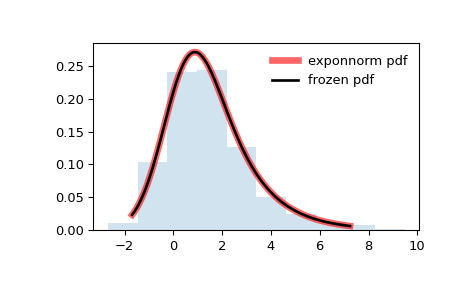scipy.stats.exponnorm¶
-
scipy.stats.exponnorm(*args, **kwds) = <scipy.stats._continuous_distns.exponnorm_gen object>[source]¶ An exponentially modified Normal continuous random variable.
As an instance of the
rv_continuousclass,exponnormobject inherits from it a collection of generic methods (see below for the full list), and completes them with details specific for this particular distribution.Notes
The probability density function for
exponnormis:\[f(x, K) = \frac{1}{2K} \exp\left(\frac{1}{2 K^2} - x / K \right) \text{erfc}\left(-\frac{x - 1/K}{\sqrt{2}}\right)\]where \(x\) is a real number and \(K > 0\).
It can be thought of as the sum of a standard normal random variable and an independent exponentially distributed random variable with rate
1/K.The probability density above is defined in the “standardized” form. To shift and/or scale the distribution use the
locandscaleparameters. Specifically,exponnorm.pdf(x, K, loc, scale)is identically equivalent toexponnorm.pdf(y, K) / scalewithy = (x - loc) / scale.An alternative parameterization of this distribution (for example, in Wikipedia) involves three parameters, \(\mu\), \(\lambda\) and \(\sigma\). In the present parameterization this corresponds to having
locandscaleequal to \(\mu\) and \(\sigma\), respectively, and shape parameter \(K = 1/(\sigma\lambda)\).New in version 0.16.0.
Examples
>>> from scipy.stats import exponnorm >>> import matplotlib.pyplot as plt >>> fig, ax = plt.subplots(1, 1)
Calculate a few first moments:
>>> K = 1.5 >>> mean, var, skew, kurt = exponnorm.stats(K, moments='mvsk')
Display the probability density function (
pdf):>>> x = np.linspace(exponnorm.ppf(0.01, K), ... exponnorm.ppf(0.99, K), 100) >>> ax.plot(x, exponnorm.pdf(x, K), ... 'r-', lw=5, alpha=0.6, label='exponnorm pdf')
Alternatively, the distribution object can be called (as a function) to fix the shape, location and scale parameters. This returns a “frozen” RV object holding the given parameters fixed.
Freeze the distribution and display the frozen
pdf:>>> rv = exponnorm(K) >>> ax.plot(x, rv.pdf(x), 'k-', lw=2, label='frozen pdf')
Check accuracy of
cdfandppf:>>> vals = exponnorm.ppf([0.001, 0.5, 0.999], K) >>> np.allclose([0.001, 0.5, 0.999], exponnorm.cdf(vals, K)) True
Generate random numbers:
>>> r = exponnorm.rvs(K, size=1000)
And compare the histogram:
>>> ax.hist(r, density=True, histtype='stepfilled', alpha=0.2) >>> ax.legend(loc='best', frameon=False) >>> plt.show()

Methods
rvs(K, loc=0, scale=1, size=1, random_state=None)
Random variates.
pdf(x, K, loc=0, scale=1)
Probability density function.
logpdf(x, K, loc=0, scale=1)
Log of the probability density function.
cdf(x, K, loc=0, scale=1)
Cumulative distribution function.
logcdf(x, K, loc=0, scale=1)
Log of the cumulative distribution function.
sf(x, K, loc=0, scale=1)
Survival function (also defined as
1 - cdf, but sf is sometimes more accurate).logsf(x, K, loc=0, scale=1)
Log of the survival function.
ppf(q, K, loc=0, scale=1)
Percent point function (inverse of
cdf— percentiles).isf(q, K, loc=0, scale=1)
Inverse survival function (inverse of
sf).moment(n, K, loc=0, scale=1)
Non-central moment of order n
stats(K, loc=0, scale=1, moments=’mv’)
Mean(‘m’), variance(‘v’), skew(‘s’), and/or kurtosis(‘k’).
entropy(K, loc=0, scale=1)
(Differential) entropy of the RV.
fit(data)
Parameter estimates for generic data. See scipy.stats.rv_continuous.fit for detailed documentation of the keyword arguments.
expect(func, args=(K,), loc=0, scale=1, lb=None, ub=None, conditional=False, **kwds)
Expected value of a function (of one argument) with respect to the distribution.
median(K, loc=0, scale=1)
Median of the distribution.
mean(K, loc=0, scale=1)
Mean of the distribution.
var(K, loc=0, scale=1)
Variance of the distribution.
std(K, loc=0, scale=1)
Standard deviation of the distribution.
interval(alpha, K, loc=0, scale=1)
Endpoints of the range that contains alpha percent of the distribution
